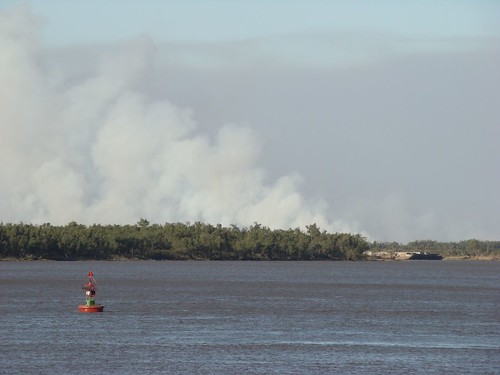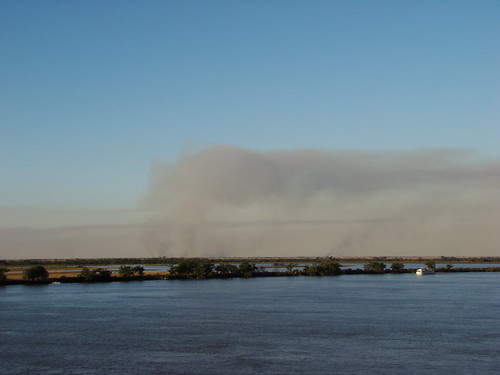Smog isn't a common word in Spanish. We're familiar with it but nobody really uses it. Our large cities naturally have some, always, but it tends not to be that visible. Buenos Aires and Rosario are on a plain beside large bodies of water and with no natural obstacles to keep airborne pollution in its place. I don't know how Córdoba manages that, but I've never heard of it having smog despite being inside a big hole.
When the owners of vast tracts of land in the Paraná Delta's islands started burning the scrubland to prepare those lands for cultivation or pasture, we got to know smog. This is etymologically correct smog I'm talking about — it's smoke plus fog, the latter being caused by cool weather and high humidity.
Now some early morning fog makes for great pictures, but smoke and ashes aren't that healthy, especially at the beginning of winter, when people's respiratory systems are already oversensitive. I didn't feel anything funny myself while taking the photo above, but then most of the blurry stuff was true fog. The lamppost you see near the center of the picture (above the guy's head) was only one block away. When you turned round, the view was much clearer, but a faint greenish-gray screen was readily apparent.
Besides that, I swear I'd never heard of so many plane delays due to smog. These are bad times for road trips too — the road blockages set up by farmers and truck drivers have stopped for the moment, but in this region (say from Rosario to Buenos Aires and around) there's so much fog and smoke that roads are totally or partially closed to traffic every day, until the sun dissolves some of the stuff. And traffic accidents are so common that the radio broadcasts the body count next to the weather forecast.
(I object to calling these "accidents", since in most cases they're caused simply by disrespect for the law, overconfidence and disregard of basic safety measures, for which Argentinians are infamously known. If you find yourself inside an airborne gray soup, the right thing to do is flash your lights appropriately and stop beside the road, no matter if you're late for work or the start of your vacations. And if you see someone stopping beside the road ahead of you, you should consider doing the same. The Argentinian's typical reaction, however, is to trust his good stars, disregard a few near misses, curse the weather, and finally crash into someone and blame the state for not forcing him to stop.)
The fires on the islands are obviously not being monitored by anyone. On any given day it's easy to spot two or more columns of smoke rising from different places along the floodplain of the Paraná, opposite the coast of Rosario.
The fires are intentional or derived from intentional ones. Though the weather might be humid, it hasn't rained a respectable amount for months (in fact the north of Santa Fe has been declared an emergency area because of the drought), so all that withered grass and plants and trees are prone to ignite at the very lightest touch of flame. The wind usually carries the smoke away toward the south (to Buenos Aires), but part of it always remains here and affects the coastal areas of the city. If I can see where it comes from, then the authorities (governors, mayors, police, judges, prosecutors, ecological management offices) can see it as well. Why does nothing happen?
















No comments:
Post a Comment
Note: Only a member of this blog may post a comment.